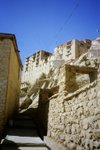New Delhi, March 27 (PTI): The frozen deserts of Ladakh once had a coastal environment millions of years ago with palm trees dotting its landscape and scientists have discovered yet another evidence of it in the form of plant fossils.
Palaeobotanists scouring the icy heights of Jammu and Kashmir came across a set of plant fossils near Tsokar in the Eastern Ladakh region a proof of the existence of a coastal environment in the region.
"The fossils belong to the middle-late Eocene period, anywhere between 45-33 million years ago," S K Paul, a senior scientist with the Dehradun-based Wadia Institute of Himalayan Geology said.
The fossils were discovered near Shingbuk, about 12 km from Tsokar which lies in the Indus Suture Zone which divides the Himalayas from the Karakoram Mountains as well as the Tibetan plateau.
The scientists claim that the fossil specimen discovered by them is diffrent from all the known species of Palmacites and have described it as a new species -- 'Palmacites tsokarensis', named after the locality from where it was collected.
"Its presence not only indicates that palms were abundant during the middle-late Eocene in the region, but also suggests that the area had not attained as much height as it has today (about 5,000 meters above mean sea level)," he said.
Paul, along with co-authors of the study -- Ram Awatar, Binita Phartiyal, A Sharma and R C Mehrotra of the Birbal Sahni Institute of Palaeobotany, Lucknow, reported their findings in the latest issue of journal 'Current Science'.
Palaeobotanists have found fossils of palm trees and even a variety of rhinoceros from the Ladakh region suggesting existence of a coastal environment and later a luxuriant vegetation in the area.
"In the tectonic interpretation it can be said that a large gap of the Tethys Ocean was consumed along this zone as a result of collision of the Indian plate with the Eurasian plate," the scientists said in their report.
The Tethys Ocean existed in the Mesozoic era, the period between 250 and 65 million years ago, between the continents of Gondwana and Laurasia.
The leaf impressions were collected from the Indus Suture Zone's Hemis Formation which is considered to belong to the middle-late Eocene period.
"The fossil remains are of a fine quality and preserved in the finer part of the siltstone horizons," Paul said.
A team of palaeobotanists led by R N Lakhanpal had discovered palm fossils -- Livistona wadiai -- in the 1980s from northeast of Hemis Gompa, a famous Buddhist temple situated about 50 km southeast of Leh.
"The present fossil, along with Livistona, indicates tropical conditions during the depositional period," Paul said.
The fossils are of a fan-shaped leaf, with the preserved lamina length of about 34 cm and a preserved width of 20 cm.

A glimpse of ladakhi daily life...
Discover Ladakhi Reggae...'Nazron ke Samne' (Yang Su Saam)
Subscribe to:
Post Comments (Atom)





1 comment:
Your blog keeps getting better and better! Your older articles are not as good as newer ones you have a lot more creativity and originality now keep it up!
Post a Comment